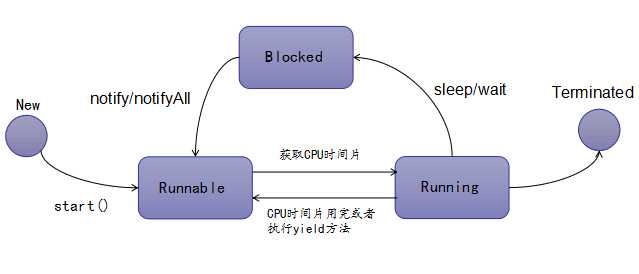[Java]多线程
2021-01-02 13:28
标签:管程 flag tran 对象 强制 timeout watch public 机制 进程:正在执行的程序。 线程:可以理解成进程中独立运行的子任务,一个进程至少有一个线程。 多线程:一个进程中有多个线程。 继承Thread类。 实现Runnable接口。 通过Callable和Future创建线程。 NEW 尚未启动的线程处于此状态。 RUNNABEL 在Java虚拟机中执行的线程处于此状态 BLOCKED 被阻塞等待监视器锁定的线程处于此状态。 WAITTING 正在等待另一个线程执行特定动作的线程处于此状态。 TIMED_WAITTING 正在等待另一个线程执行动作达到指定等待时间的线程处于此状态。 TERMINATED 已退出的线程处于此状态。 线程的优先级用数字表示,范围从1~10。 使用getPriority()、setPriority()获取或者改变优先级。 优先级低只是意味着获得CPU调度的概率低。 线程分为用户线程和守护线程。 虚拟机必须确保用户线程执行完毕。 虚拟机不用等待守护线程执行完毕。 不安全的买票: 不安全的取钱: 不安全的集合: 安全的买票:将买票方法设置为同步方法 安全的取钱:用同步代码块锁住Account对象。 安全的集合:用同步代码块锁住List对象,这里也可以用线程安全的 产生死锁的四个必要条件: 从JDK 5.0 开始,Java提供了更强大的线程同步机制,通过显示定义同步锁对象来实现同步。同步锁使用Lock对象。 锁提供了对共享资源的独占访问,每次只能有一个线程对Lock对象加锁,线程开始访问共享资源之前应先获得Lock对象。 ReentrantLock(可重入锁)类实现了Lock,它拥有了与synchronized相同的并发性和内存语义,在实现线程安全的控制中,比较常用的是ReentrantLock,可以显式加锁、释放锁。 synchronized和Lock的区别: Java提供了几个方法来解决线程之间的通信问题。 生产者消费者模式: 管程法(利用缓冲区) 信号灯法(利用标志位) 提前创建好多个线程,放入线程池,使用时直接获取,使用完放回池中。 使用线程池的好处: JDK 5.0起提供了线程池相关的API:ExecutorService和Executors。 [Java]多线程 标签:管程 flag tran 对象 强制 timeout watch public 机制 原文地址:https://www.cnblogs.com/baihan/p/12994181.html多线程
一、什么是多线程?
二、为什么要使用多线程?
三、线程的生命周期

四、创建线程的三种方法
public class TestThread extends Thread{
@Override
//重写run方法
public void run() {
for (int i = 0; i public class TestRunnable implements Runnable{
@Override
public void run() {
for (int i = 0; i public class TestCallable implements Callable五、线程停止、休眠、礼让、强制执行
Thread.sleep(1000):线程休眠1s。Thread.yield():礼让看CPU心情。Thread.join():等到此线程执行完,再执行其他线程。六、线程状态
Thread.State
七、线程的优先级
八、守护线程
thread.setDaemon(true):设置为守护线程。九、线程同步
十、线程三大不安全案例
public class UnsafeBuyTicket {
public static void main(String[] args) {
BuyTicket station = new BuyTicket();
new Thread(station,"小猪").start();
new Thread(station,"小鸡").start();
new Thread(station,"小狗").start();
}
}
class BuyTicket implements Runnable{
private int ticketNums = 10;
boolean flag = true;//外部停止方式
@Override
public void run() {
while(flag){
try {
buy();
} catch (InterruptedException e) {
e.printStackTrace();
}
}
}
public void buy() throws InterruptedException {
if(ticketNums public class UnsafeBank {
public static void main(String[] args) {
Account account = new Account(100, "结婚基金");
Drawing me = new Drawing(account,50,"我");
Drawing anotherMe = new Drawing(account,100,"平行空间里的我");
me.start();
anotherMe.start();
}
}
//账户
class Account{
int money;
String name;
public Account(int money, String name){
this.name = name;
this.money = money;
}
}
//银行
class Drawing extends Thread{
int nowMoney;
Account account;
int drawingMoney;
String name;
public Drawing(Account account, int drawingMoney, String name){
super(name);
this.account = account;
this.drawingMoney =drawingMoney;
}
@Override
public void run() {
if(account.money-drawingMoney public class UnsafeList {
public static void main(String[] args) {
ArrayList十一、同步方法和同步块(解决线程不安全)
public synchronized void buy(){}。public class SafeBuyTicket {
public static void main(String[] args) {
BuyTicket station = new BuyTicket();
new Thread(station,"小猪").start();
new Thread(station,"小鸡").start();
new Thread(station,"小狗").start();
}
}
class BuyTicket implements Runnable{
private int ticketNums = 10;
boolean flag = true;//外部停止方式
@Override
public void run() {
while(flag){
try {
buy();
} catch (InterruptedException e) {
e.printStackTrace();
}
}
}
public synchronized void buy() throws InterruptedException {
if(ticketNums public class SafeBank {
public static void main(String[] args) {
Account account = new Account(100, "结婚基金");
Drawing me = new Drawing(account,50,"我");
Drawing anotherMe = new Drawing(account,100,"平行空间里的我");
me.start();
anotherMe.start();
}
}
//账户
class Account{
int money;
String name;
public Account(int money, String name){
this.name = name;
this.money = money;
}
}
//银行
class Drawing extends Thread{
int nowMoney;
Account account;
int drawingMoney;
String name;
public Drawing(Account account, int drawingMoney, String name){
super(name);
this.account = account;
this.drawingMoney =drawingMoney;
}
@Override
public void run() {
synchronized (account){
if(account.money-drawingMoney CopyOnWriteArrayList集合。public class SafeList {
public static void main(String[] args) {
ArrayList十二、死锁
十三、Lock(显示定义同步锁)
private final ReentrantLock lock = new ReentrantLock();
lock.lock();
//业务逻辑...
lock.unlock();//如果同步代码有异常,可以将解锁操作放到try...catch的finally里
十四、线程通信
方法名
作用
wait()
表示线程一直等待,直到其他线程通知,与sleep不同,会释放锁。
wait(long timeout)
指定等待的毫秒数。
notify()
唤醒一个处于等待状态的线程。
notifyAll()
唤醒同一个对象上所有调用wait()方法的线程,优先级高的线程优先调度。
public class PAC {
public static void main(String[] args) {
Container container = new Container();
new Producer(container).start();
new Customer(container).start();
}
}
class Producer extends Thread{
Container container;
public Producer(Container container){
this.container = container;
}
@Override
public void run() {
for (int i = 0; i public class PAC2 {
public static void main(String[] args) {
TV tv = new TV();
new Performer(tv).start();
new Viewer(tv).start();
}
}
class Performer extends Thread{
private TV tv;
public Performer(TV tv){
this.tv = tv;
}
@Override
public void run() {
for (int i = 0; i 十五、线程池
public class ThreadPool {
public static void main(String[] args) {
ExecutorService service = Executors.newFixedThreadPool(10);//创建容量为10的线程池
service.execute(new Thread(()->{System.out.println(Thread.currentThread().getName());}));//开启线程
service.execute(new Thread(()->{System.out.println(Thread.currentThread().getName());}));
service.execute(new Thread(()->{System.out.println(Thread.currentThread().getName());}));
service.shutdown();
}
}